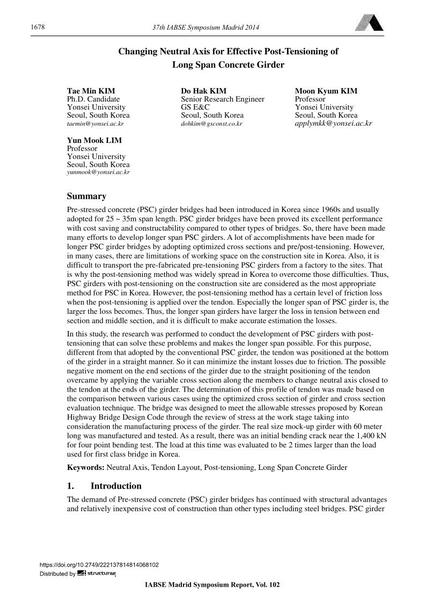Changing Neutral Axis for Effective Post-Tensioning of Long Span Concrete Girder

|
|
|||||||||||
Détails bibliographiques
| Auteur(s): |
Tae Min Kim
Do Hak Kim Moon Kyum Kim Yun Mook Lim |
||||
|---|---|---|---|---|---|
| Médium: | papier de conférence | ||||
| Langue(s): | anglais | ||||
| Conférence: | IABSE Symposium: Engineering for Progress, Nature and People, Madrid, Spain, 3-5 September 2014 | ||||
| Publié dans: | IABSE Symposium Madrid 2014 | ||||
|
|||||
| Page(s): | 1678-1684 | ||||
| Nombre total de pages (du PDF): | 7 | ||||
| Année: | 2014 | ||||
| DOI: | 10.2749/222137814814068102 | ||||
| Abstrait: |
Pre-stressed concrete (PSC) girder bridges had been introduced in Korea since 1960s and usually adopted for 25 ~ 35m span length. PSC girder bridges have been proved its excellent performance with cost saving and constructability compared to other types of bridges. So, there have been made many efforts to develop longer span PSC girders. A lot of accomplishments have been made for longer PSC girder bridges by adopting optimized cross sections and pre/post-tensioning. However, in many cases, there are limitations of working space on the construction site in Korea. Also, it is difficult to transport the pre-fabricated pre-tensioning PSC girders from a factory to the sites. That is why the post-tensioning method was widely spread in Korea to overcome those difficulties. Thus, PSC girders with post-tensioning on the construction site are considered as the most appropriate method for PSC in Korea. However, the post-tensioning method has a certain level of friction loss when the post-tensioning is applied over the tendon. Especially the longer span of PSC girder is, the larger the loss becomes. Thus, the longer span girders have larger the loss in tension between end section and middle section, and it is difficult to make accurate estimation the losses. In this study, the research was performed to conduct the development of PSC girders with post- tensioning that can solve these problems and makes the longer span possible. For this purpose, different from that adopted by the conventional PSC girder, the tendon was positioned at the bottom of the girder in a straight manner. So it can minimize the instant losses due to friction. The possible negative moment on the end sections of the girder due to the straight positioning of the tendon overcame by applying the variable cross section along the members to change neutral axis closed to the tendon at the ends of the girder. The determination of this profile of tendon was made based on the comparison between various cases using the optimized cross section of girder and cross section evaluation technique. The bridge was designed to meet the allowable stresses proposed by Korean Highway Bridge Design Code through the review of stress at the work stage taking into consideration the manufacturing process of the girder. The real size mock-up girder with 60 meter long was manufactured and tested. As a result, there was an initial bending crack near the 1,400 kN for four point bending test. The load at this time was evaluated to be 2 times larger than the load used for first class bridge in Korea. |
||||
